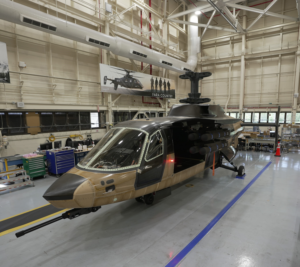The House Armed Services Tactical Air and Land Forces Subcommittee has proposed limiting travel funds for the Secretary of the Army until the service submits the Analysis of Alternatives (AoA) study for the Future Attack Reconnaissance Aircraft (FARA) program.
The provision is included in the subcommittee’s draft portion of the fiscal year 2024 National Defense Authorization Act, which the panel is expected to approve on Tuesday.

Specifically, the directive would withhold 30 percent of the Office of the Secretary of the Army’s travel budget until the congressional defense committees receive the AoA study, which assesses potential procurement pathway options and alternatives for the FARA program.
FARA is the Army’s program to field a new scout attack helicopter, having selected Bell’s [TXT] 360 Invictus and Sikorsky’s [LMT] Raider X designs for the current competitive prototyping phase.
Rep. Rob Wittman (R-Va.), the subcommittee’s chair, pressed Army officials during an April hearing on the status of the AoA study and why the process was only occurring now rather than several years ago (Defense Daily, April 20).
“It’s alarming to me that those haven’t been done to this point. To me, that should have been done earlier in the process. And we’re seeing that being delayed now,” Wittman said at the time. “If at this particular point with as much investment that’s been made, which is now about $2 billion, what if an AoA shows that there’s a better alternative. It seems like we’ve spent an awful lot of money if we end up in a different place. And if that’s the case, I don’t want to repeat the same challenges the Army went through with [canceled] Comanche [helicopter program].”
Doug Bush, the Army’s top acquisition official, said during the April hearing the service initiated the AoA process once it settled on a traditional acquisition approach for FARA, which requires the study to be completed before making a Milestone B decision.
“To be fair to my predecessors, I believe there was hope at the time to be able to go perhaps earlier to a Milestone C-type approach or even perhaps rapid fielding. But based on where the program is and the technology, we decided the more responsible approach would be to go to a traditional Milestone B, which requires the AoA,” Bush said at the hearing. “Ultimately, the decision on moving forward on the Milestone B will belong to [DoD Acquisition Executive Bill] LaPlante, advised by the Army, CAPE and others. I think I’m confident though that the AoA, the way it’s structured, is fair. It is very thorough. It is examining many alternatives. I think that’s good.”
Senior Army aviation officials confirmed in late April delivery of the service’s new General Electric Aviation [GE]-built helicopter engine to the FARA competitors is set for this fall, adding they’re “committed” to the system following several delays (Defense Daily, April 28).
The Army has faced several delays in getting the GE T901 engine, developed under Improved Turbine Engine Program (ITEP), to Bell and Sikorsky, with Bush previously citing “manufacturing challenges” with the program.
The new delivery timeline for the T901 engine puts first flights for the FARA prototypes on track for next year.
GE Aviation was awarded a $517 million contract in February 2019 to develop its T901 engine for the Improved Turbine Engine Program, which will eventually power the Army’s AH-64 Apache and UH-60 Black Hawk helicopters as well as the future FARA platform.